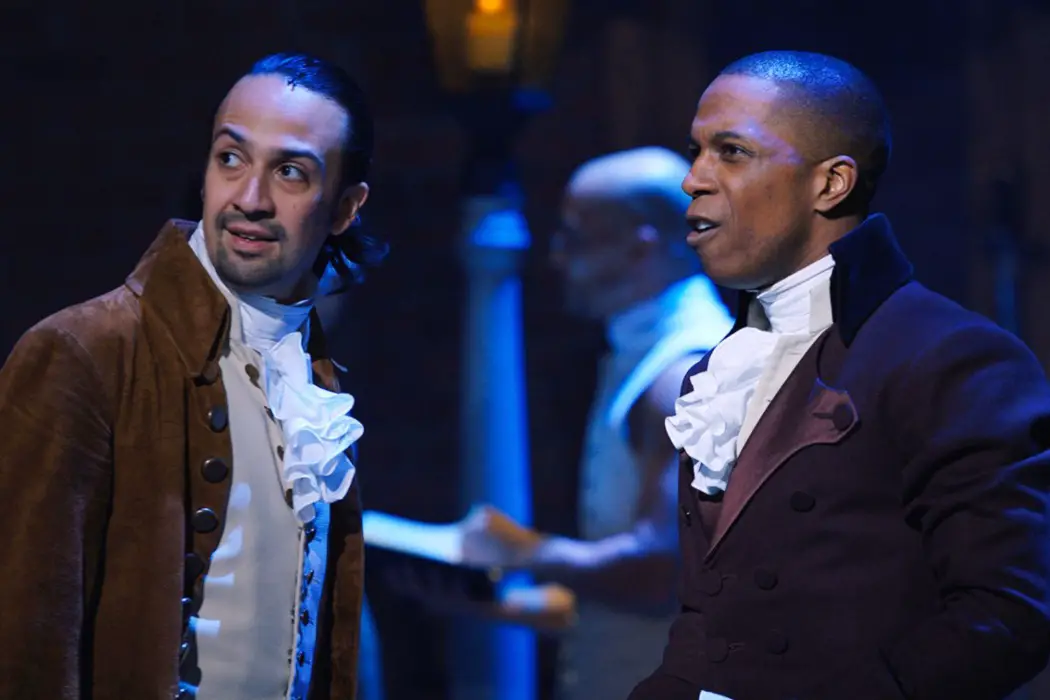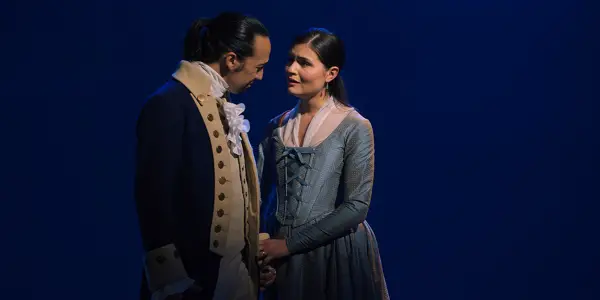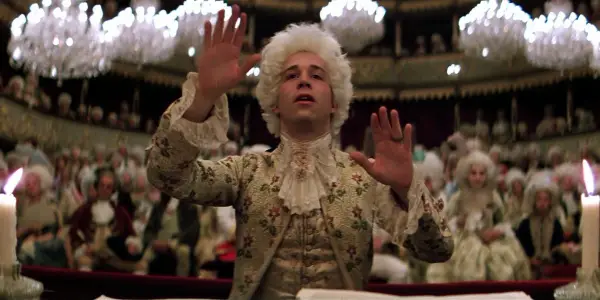HAMILTON & AMADEUS: A Perfect Double Feature

Currently working on his Bachelor's in Media Arts with a…
With a filmed version finally being released on Disney+, fans and newcomers alike no longer have to enter a literal lottery for tickets or dig deep into their savings to have the chance to see Hamilton once from a seat fifty feet away, directly behind the world’s first human giraffe. Those that did, however, might not be taking it too well now that the exclusive hot-ticket item they used to brag about seeing to friends can now be experienced from your toilet at 3 am for the price of a coffee.
Nevertheless, this long-awaited occasion of its streaming debut early last month awards the broadway hit, in my eyes, its place in the world of film, and I encourage everyone to welcome it in open arms as an honorary member. And as an honorary member in the world of film comes the inevitable question: What double feature could you watch with it?
Though Hamilton may not be a film the same way other items on catalogs of other streaming sites may be, and my more purist film snob side may attest to that, I firmly believe that it’s enough of one to become part of a sacred ritual, deep in film major and movie buff tradition, that I like to call the fantasy double feature.
Not everyone does it, but those that do, do it viciously – self-proclaimed cinephiles and casual fans alike who’ve all grown bored of the same old way of watching movies who will look back on their favorites and try to pair them up with one another like some nerdy matchmaker. Two movies are joined together in holy matrimony as the perfect double feature, watched back-to-back, and a weird sort of fantasy of the perfect drive-in movie experience is created.
An Unlikely Pairing
There are many examples of this sort of thing out there – with a wide variety of ways and reasons to put movies together in all different kinds of combinations. You can group movies together in a showcase of distinct directorial style like you would Goodfellas and Casino or Memento and Insomnia, or simply by their similar themes like Eternal Sunshine of the Spotless Mind and Her or The Cabinet of Dr Caligari and The Elephant Man.

But there is a third, quite possibly the best option of putting two movies together: two films in such close proximity to one another in terms of beat-by-beat character arc, story, themes, that it’s almost creepy that they aren’t related.
Though it doesn’t make my skin crawl to think that one work might have inspired another, I would place it under the realm of unusual that both of these stories based heavily on the real-life events of their respective historical figures happened to have virtually indistinguishable beat-by-beat plot points straight out of a curated Shakespearean tragedy.
So What Makes Hamilton and Amadeus Such A Double Feature Power Couple?
Good question. And it’s one that was in part answered just earlier as these two movies both share amazing similarities to one another: biographical re-tellings of the rise to fame of their titular historical figures told in a way that uses the unique perspective of their tragically overshadowed adversaries. But it doesn’t end there. It’s in the latter part that both of these movies find their specialty as Aaron Burr and Antonio Salieriare both beautifully layered and multi-dimensional examples of something I like to call: “The Antagonized Protagonist”.
Cheesy made-up terminology aside, what an “Antagonized Protagonist” might mean, if it was a phrase ever made legitimate, is very simply whenever the villain or decided “bad guy” of a story is the protagonist. And wherever the protagonist lies on the spectrum of villainy makes this trope such a varied one. One end of the extreme is “tragic victim of circumstance”, as featured in Seth Brundle’s character in 1986’s The Fly. On another, very far end is the “irredeemable psychopath with little to no redeeming qualities ” (2019’s Joker, 2013’s The Wolf of Wall Street).
So as you can see, this “Antagonized Protagonist”, though it doesn’t have one clear-cut definition, only really requires that whichever character leads us through the story in their point of view is someone who is engaging and interesting to watch, morality and this so-called decency of their actions aside.

So where do Aaron Burr and Antonio Salieri fall on this line? And what makes them the protagonists in two movies called Hamiltion and Amadeus, both of which pretty strongly imply their being about the people’s who’s namesake are in the titles themselves?
Well, I’m glad to say that our two “Antagonized Protagonists” are really nowhere near the same place on the line as the likes of Arthur Fleck or Jordan Belfort in The Joker or The Wolf of Wall Street. Burrand Salieriare villains only in the sense that they were adversaries to their movie’s titular heroes. Much of what they did falls almost exactly dead-on center on the end of “tragic victim of circumstance.”
I felt as they deserve that honor since, putting any historical inaccuracies for the sake of dramatization aside, I never really once strayed from empathizing with either Burror Salieri for each their entire film’s runtime, and fully understood their tragic plight: a young hotshot, new in the game, and given their chance to climb the ladder of their career by a colleague who both secretly admires this prodigy, as well as, still in secret, makes them their rival, all while their relationship is that of perfectly good friends on the outside.
It’s a situation fraught with great potential for conflict both external and internal, driven almost solely by the power-hungry engine of these misguided and frustrated characters; these footnotes in history seeking fame and security for their legacy in which they ironically find in being forever known as the person who killed Alexander Hamilton or practically drove to an early grave, Wolfgang Amadeus Mozart.
Conclusion
Self-tailored, fantasy-satisfying double features aren’t at all really unusual, but for a lot of people, the idea of doing it with two movies that mirror each other in almost every plot-related way isn’t quite their cup of tea. And that’s okay. No one said you had to enjoy exactly the same tea I do, let alone drink it. I encourage you, please, to find your own.
Whether it’s two movies that share similar, but not exact themes, or inexplicably have the same overall vibe, or even just share the same actor, it’s up to you what kind of double feature you want to make. They make a lot of flavors of tea. It just so happens two movies with identical tropes of misunderstood historical villains reaching for fame and letting their jealousy consume them to the point that the fame they get is of utmost infamy is mine.
How about you? What’s your perfect double feature? Let us know in the comments!
Does content like this matter to you?
Become a Member and support film journalism. Unlock access to all of Film Inquiry`s great articles. Join a community of like-minded readers who are passionate about cinema - get access to our private members Network, give back to independent filmmakers, and more.
Currently working on his Bachelor's in Media Arts with a Minor in English, William's movie taste consists of a sad overindulgence in anything Charlie Kaufman, Pre-2011 Pixar, or the works of The Holy David Trinity (Lynch, Lean, & Fincher). He also would like to add that any queries you may have regarding the latest in roller coasters, why 3d Blu-ray gets a bad rap, or the importance of music in movies and musical theatre should be directed to him.












